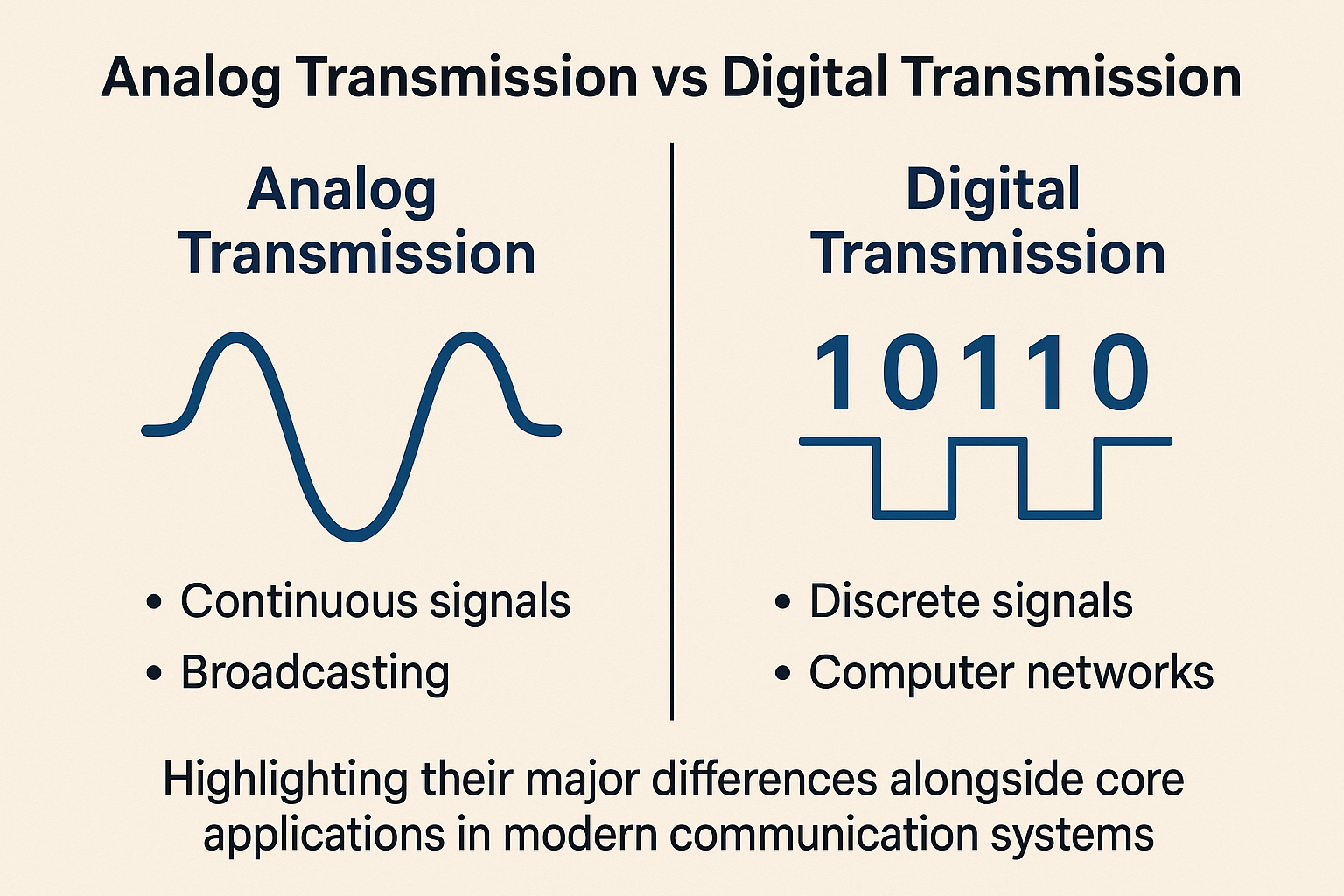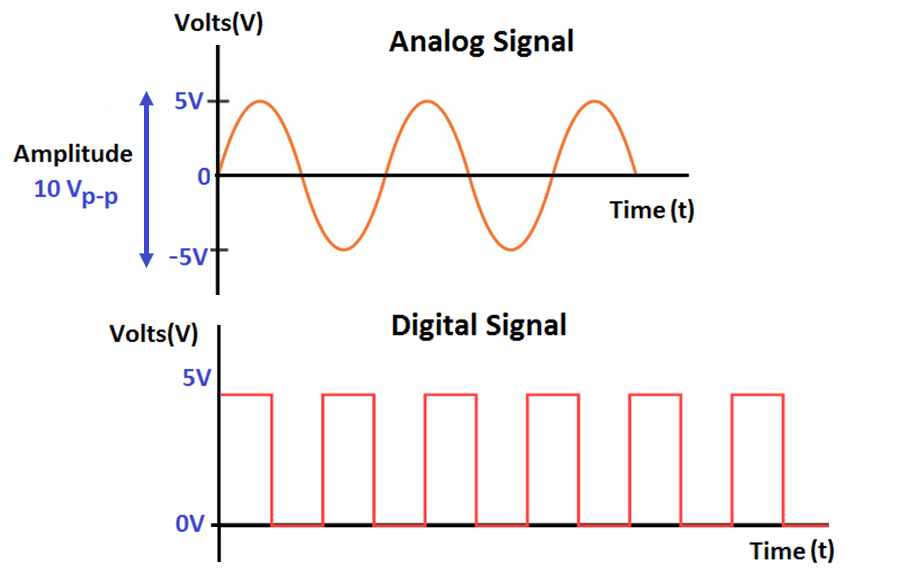Analog Transmission vs Digital Transmission: Highlighting their major differences alongside core applications in modern communication systems
Analog and digital signal transmission are widely used throughout the field of computer networking and modern communication systems. This unikeyic Electronics article discusses the operation of analog and digital transmission, application differences as well as their advantages and disadvantages.
Analog transmission includes sending information with the help of a continuous signal that can change in terms of amplitude,frequency or phase. It directly models signal-like real-world phenomena like sound, light, or temperature, and it is appropriate to use with naturally varying signals. Conversely, digital transmission is the transmission of information in discrete binary symbols which are usually 0s and 1s. This technology is the basis of the current communication system, such as the internet, digital electronics, and mobile networks.

|
Attributes |
Analog Signal Transmission |
Digital Signal Transmission |
|
Signal Type |
Continuous waveforms (e.g., sine wave) |
Discrete binary pulses (0s and 1s) |
|
Transmission Medium |
Copper wires, coaxial cables, fiber optics, air (radio) |
Same media, often with additional encoding (Ethernet, USB, fiber, wireless) |
|
Noise Sensitivity |
Very sensitive to noise even minor noise can actually make signal degrade |
Low-error detection/correction is capable of eliminating out minor noise |
|
Signal Degradation |
Gradually degrades over distance due to attenuation and interference |
Maintains integrity longer; can be regenerated by repeaters |
|
Bandwidth Requirement |
Less (suitable when continuous data length is long) |
More (induced by encoding, clock signals, etc.) |
|
Error Detection/Correction |
Difficult – analog errors are hard to isolate |
Easy – binary data allows parity checks, CRC, and correction algorithms |
|
Amplification |
Amplifies both signal and noise |
Regeneration restores original clean signal |
|
Quality |
Subject to distortion, noise, and signal loss |
More consistent and reliable quality |
|
Transmission Rate |
Typically slower for complex data |
High-speed transmission is possible |
|
Examples |
AM/FM radio, analog TV, landline voice signals |
Internet data, digital TV, USB, Bluetooth, VoIP |

Why in some cases analog transmission is preferred over digital transmission?
While digital transmission dominates modern communication due to its highly robust, error-tolerant systems, analog transmission is still preferred in certain cases. Here's why analog transmission may be chosen over digital in specific scenarios:
|
Reason |
Explanation |
|
Natural Representation of Real-World Signals |
Analog signals are in continuum such as sound, light, or temperature, so they can be used to directly represent them without conversion. |
|
Easier to build simple functions |
Simple applications where the signal is intended to be analog (e.g. Voice communication, voice DTMF, walkie-talkies, intercom) are simpler and less costly to construct using analog circuits. |
|
Lower Cost (in Some Scenarios) |
Sometimes ANALOG DEVICES such as radios or microphones can be cheaper since they do not require digital components. |
|
Lower Delay |
In contrast to analog, no conversion or processing delays are introduced, and so there is minimal delay present in analogue systems, perfect where some delay could be detrimental, such as audio mixing or other real-time applications. |
|
No converters required |
The ADCs and DACs used in analog systems are not necessary, cost less and are far less complex. |
|
Used in Certain Broadcasting Systems |
Analog AM/FM radio and older television systems continue to use analog, since they are fairly basic and already established. |
|
Fidelity at High Quality |
In some high-end audio applications (like analog vinyl or studio equipment), enthusiasts prefer the warmth and continuous detail of analog sound. |
Analog Transmission vs Digital Transmission: Application Differences
|
Application Area |
Analog Transmission |
Digital Transmission |
|
Audio Broadcasting |
AM/FM Radio – analog modulation used to transmit voice and music over airwaves. |
Digital Radio (e.g., DAB) – transmits compressed digital audio with metadata (e.g., song titles). |
|
Telephony |
Traditional landline phones – use analog voice transmission. |
VoIP & Mobile Calls – voice is digitized and sent over IP or cellular networks. |
|
Television |
Analog TV (NTSC, PAL) – analog video/audio signals transmitted over the air. |
Digital TV (DVB, ATSC) – transmits compressed digital video/audio for higher quality and more channels. |
|
Data Communication |
Not suitable for binary data; rarely used for computer networks. |
Internet, Ethernet, Wi-Fi, 4G/5G – digital transmission enables fast, reliable communication. |
|
Surveillance (CCTV) |
Analog CCTV – analog video over coaxial cables. |
IP Cameras – digital video over network cables or Wi-Fi, supports HD and remote access. |
|
Recording and Playback |
Vinyl records, cassette tapes – analog storage and transmission of audio. |
CDs, MP3 players, streaming services – digital encoding and transmission for cleaner audio. |
|
Medical Devices |
ECG/EEG machines (older models) – analog waveform recordings. |
Modern digital monitors – digitize analog signals for processing, storage, and remote monitoring. |
|
Instrumentation & Control |
Analog sensors and control systems – direct voltage/current signal used. |
Digital control systems (PLC, DCS) – analog sensor data digitized for logic-based control. |
Key Features of Analog Transmission
|
Key Characteristics |
Description |
|
Signal Type |
Continuous – can take any value within a range |
|
Real-time nature |
No conversion delays; Direct signal flow. |
|
Modulation |
Uses methods like AM (Amplitude Modulation), FM (Frequency Modulation), or PM (Phase Modulation) to encode data |
|
Encoding |
Not required. Transmits raw signal as-is, without digitization |
|
Tuning |
Tuning is required during modulation and demodulation, analog transmission often requires precise frequency handling |
|
Mediums |
Copper wires, coaxial cables, fiber optics, airwaves (radio waves) |
|
Transmission Quality |
Can degrade due to noise, attenuation, and interference |
|
Amplification |
Analog amplifiers boost the signal but also amplify noise |
|
Distance Limitations |
Signal strength and quality reduce over long distances without repeaters |
Pros of Analog Transmission
|
Advantage |
Explanation |
|
Natural Signal Representation |
The analog transmission is similar to natural signals (such as sound, light and temperature) and is therefore effective in natural signal direct capture and transmission. |
|
Low Latency |
Does not require digital encoding/decoding, hence it is high speed on real-time transmission (e.g. live audio mixing). No delay of processing. |
|
Simple Hardware |
Circuits such as amplifier, filter and transmitter can be simpler and cheaper to put together in basic application. |
|
Cost-Effective (in Small Systems) |
Analog systems can be less expensive where the distance traveled is short (e.g. analog radios) or over a relatively basic channel. |
|
Effective for Broadcast |
Analog modulation (AM/FM) works well for broadcasting audio to many users over radio waves. |
Cons of Analog Transmission
|
Disadvantage |
Explanation |
|
Noise Sensitivity |
Analog signals degrade easily due to noise, interference, and attenuation— Limited range and poor signal integrity over long distances. |
|
Signal Loss & Distortion |
Amplifying analog signals also amplifies noise, causing quality to drop significantly over time or distance. |
|
No Error Correction |
Analog transmission lacks robust methods to detect or correct errors caused during transmission. |
|
Hard to Store & Process |
Continuous signals are difficult to store in modern digital storage devices without converting to digital first. |
|
Limited Bandwidth Efficiency |
Analog signals require more bandwidth for equivalent quality compared to compressed digital signals. |
|
Lack of Security |
Analog signals are harder to encrypt and secure compared to digital data streams. |
Key Features of Digital Transmission
|
Key Characteristics |
Description |
|
Signal Type |
Discrete (digital) – only specific values (e.g., 0 and 1) |
|
Encoding Methods |
Uses techniques like NRZ, Manchester coding, QAM, or baseband modulation |
|
Transmission Medium |
Twisted-pair cables, coaxial cables, fiber optics, wireless (Wi-Fi, 4G/5G) |
|
Signal Regeneration |
Signals can be regenerated to original form, removing accumulated noise |
|
Error Handling |
Supports error detection and correction (e.g., parity, CRC, Hamming codes) |
|
Multiplexing |
Supports time-division and frequency-division multiplexing easily |
Pros of Digital Transmission
|
Advantage |
Simplified Explanation |
|
Noise Resistance |
Digital signals can handle noise better—small changes usually don’t affect the data. |
|
Signal Regeneration |
Repeaters can clean and restore digital signals even after long-distance travel. |
|
Error Checking |
Built-in methods can detect and fix errors during data transfer. |
|
Data Security |
Digital systems support encryption to keep information safe. |
|
Easy to Store and Compress |
Digital data can be stored on drives and compressed to save space. |
|
Software Control |
Systems can be updated or changed easily using software. |
|
High-Speed Communication |
Enables fast technologies like fiber internet, 5G, and broadband. |
|
Multiplexing and Integration |
Many digital signals can be sent together using smart techniques like TDM or FDM. |
Cons of Digital Transmission
|
Disadvantage |
Simplified Explanation |
|
More Complex Hardware |
Needs extra parts like ADCs, DACs, and processors to work. |
|
Higher Power Use |
Some digital systems use more power, especially at high speeds. |
|
Needs Proper Timing |
The sender and receiver must stay in sync to understand the data. |
|
More Bandwidth Needed |
Digital signals may take up more space, especially if not compressed. |
|
Conversion Needed |
Analog-to-digital and digital-to-analog conversion adds cost, latency, and potential for signal loss. |
|
Quantization Errors |
During ADC, small details of the original analog signal may be lost (unless high resolution is used). |






















